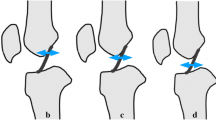Summary
The purpose of our study was to compare the diagnostic performance of a 0.2-T MRI unit and a 1.0-T MRI unit in the evaluation of the anterior cruciate ligament in patients with clinically suspected lesions of this ligament. Twenty four patients with clinically suspected lesions of the anterior cruciate ligament underwent MRI of the knee on both 0.2-T and 1.0-T MRI units. Three independent observers evaluated the examinations for primary and secondary signs of a tear of the anterior cruciate ligament. Frequency of these signs was determined for both modalities, and observer agreement was assessed using the kappa statistic. Sixteen of 24 patients had signs of tears of the anterior cruciate ligament on the 1.0-T unit; the 0.2-T unit detected primary signs in 15/16 (93 %) patients and secondary signs in 7/12 (43 %) patients. In 8 patients the 1.0 T unit showed neither primary nor secondary signs for tears of the anterior cruciate ligament; in these patients the 0.2-T unit detected primary signs in 1/8 cases (12 %), and secondary signs in 3/8 cases (37 %). Observer agreement was very good for the 1.0-T unit and fair for the 0.2-T unit. There is no substantial difference between 1.0-T units and 0.2-T MRI units in the visualisation of primary signs of tears of the anterior cruciate ligament. In the visualisation of secondary signs, 1.0-T units are superior to 0.2-T units, and there is a surprisingly high rate of false-positive results with the 0.2-T unit. As to the reproducibility of the results, the 1.0-T unit is far superior to the 0.2-T unit.
Zusammenfassung
Ziel unserer Studie war es, die diagnostische Wertigkeit eines 0,2-T-Gerätes im Vergleich mit einem 1,0-T-Gerät bei der Beurteilung von Patienten mit klinisch suspizierten Läsionen des vorderen Kreuzbandes zu untersuchen. 24 Patienten mit klinisch suspizierter Läsion am vorderen Kreuzband wurden sowohl auf einem 0,2-T-Gerät als auf einem 1,0-T-Gerät untersucht. Drei unabhängige Untersucher beurteilten für beide Geräte das Vorhandensein oder das Fehlen direkter und/oder indirekter Zeichen für eine Läsion des vorderen Kreuzbands. Die Frequenz direkter und indirekter Zeichen für beide Modalitäten wurde ermittelt, die Übereinstimmung zwischen den Untersuchern wurde mittels Kappa-Statistik errechnet. 16/24 Patienten wiesen auf dem 1,0-T-Gerät Zeichen einer Läsion des vorderen Kreuzbands auf; hiervon konnte das 0,2-T-Gerät bei 15/16 (93 %) Patienten die direkten Zeichen und in 7/12 (43 %) die indirekten Zeichen darstellen. Bei 8 Patienten zeigte das 1,0-T-Gerät weder direkte noch indirekte Zeichen einer Läsion des vorderen Kreuzbandes; hier kamen durch das 0,2-T-Gerät in 1/8 Patienten (12 %) direkte und in 3/8 Patienten indirekte Zeichen einer Läsion des vorderen Kreuzbandes zur Darstellung. Die Übereinstimmung zwischen den Untersuchern war für das 1,0-T-Gerät sehr gut, für das 0,2-T-Gerät mäßig. In der Darstellung direkter Zeichen für eine Läsion des vorderen Kreuzbandes gibt es zwischen dem 0,2-T-Gerät und dem 1,0-T-Gerät keinen substantiellen Unterschied. In der Darstellung indirekter Zeichen ist das 1,0-T-Gerät dem 0,2-T-Gerät überlegen, wobei das 0,2-T-Gerät eine überraschend hohe Zahl falsch-positiver indirekter Zeichen nachweisen dürfte. In bezug auf die Interobservervariabilität hat das 1,0-T-Gerät gegenüber dem 0,2-T-Gerät klare Vorteile.
Similar content being viewed by others
Author information
Authors and Affiliations
Rights and permissions
About this article
Cite this article
Bankier, A., Breitenseher, M., Trattnig, S. et al. MRI diagnosis of anterior cruciate ligament lesions: comparison of 1.0 T and 0.2 T. Early results. Radiologe 37, 807–811 (1997). https://doi.org/10.1007/s001170050286
Issue Date:
DOI: https://doi.org/10.1007/s001170050286




